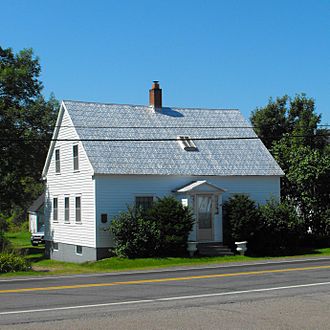Elizabeth Bishop House facts for kids
Quick facts for kids Elizabeth Bishop House |
|
|---|---|
 |
|
| General information | |
| Architectural style | Classical Revival |
| Town or city | 8740 No 2 Highway Great Village Nova Scotia |
| Country | Canada |
| Technical details | |
| Structural system | Wooden frame vernacular |
| Type: | Provincially Registered Property |
| Designated: | 1973-05-21 |
| Reference #: | 00PNS0221 |
The Elizabeth Bishop House, also known as the Bulmer House, is a special historic home in Great Village, Nova Scotia. Today, it's a quiet place where artists can stay and work. This house is famous because of Elizabeth Bishop, a writer who won the Pulitzer Prize. When she was young, Elizabeth spent her summers here with her grandparents, William Brown Bulmer and Elizabeth (Hutchinson) Bulmer.
Many of Elizabeth Bishop's stories and poems were inspired by her time in Great Village and Nova Scotia. For example, her story "In the Village" and her poem "Filling Station" both show parts of this area. The Bulmer family bought the property in 1874, but we don't know exactly when the house was built. On May 21, 1997, the Bulmer House became a Nova Scotia Provincially Recognized Heritage Site. It was recognized for its connection to Elizabeth Bishop and her writings, and also for its beautiful architecture. It's a great example of a typical 1½-storey Classical Revival house from the early 1800s, a style often seen in rural Nova Scotia.
Contents
Who Was Elizabeth Bishop?
Elizabeth Bishop (1911–1979) was an important American poet and short-story writer. She was born in Massachusetts, USA, but her father died when she was very young. Her mother then became ill, so Elizabeth spent parts of her childhood living with different relatives. Her summers in Great Village, Nova Scotia, with her grandparents were very important to her.
Bishop's Famous Works
Elizabeth Bishop wrote many famous poems and stories. She was known for her detailed descriptions and her unique way of looking at the world. Her writing often explored themes of travel, geography, and memory. She won the Pulitzer Prize for Poetry in 1956 for her book Poems: North & South – A Cold Spring. Her connection to the Elizabeth Bishop House shows how places can inspire great art.
The House's History and Style
The Elizabeth Bishop House has a long history. While the Bulmer family bought the land in 1874, the house itself is much older. It was likely built sometime between 1800 and 1850. This makes it a very old and important building in the area.
What Does "Classical Revival" Mean?
The house is built in the Classical Revival style. This means it looks back to the ancient Greek and Roman buildings for inspiration. You might see features like balanced shapes, simple lines, and a grand, formal look. For a house, this often means a symmetrical front, a central doorway, and windows placed evenly. The Elizabeth Bishop House is a good example of this style, which was popular in Nova Scotia during that time.
The House Today
Today, the Elizabeth Bishop House is no longer a private family home. It has been turned into a special place for artists. It serves as a retreat where writers, poets, and other artists can come to find inspiration, just like Elizabeth Bishop did. This helps keep her memory alive and continues the house's connection to creativity.

